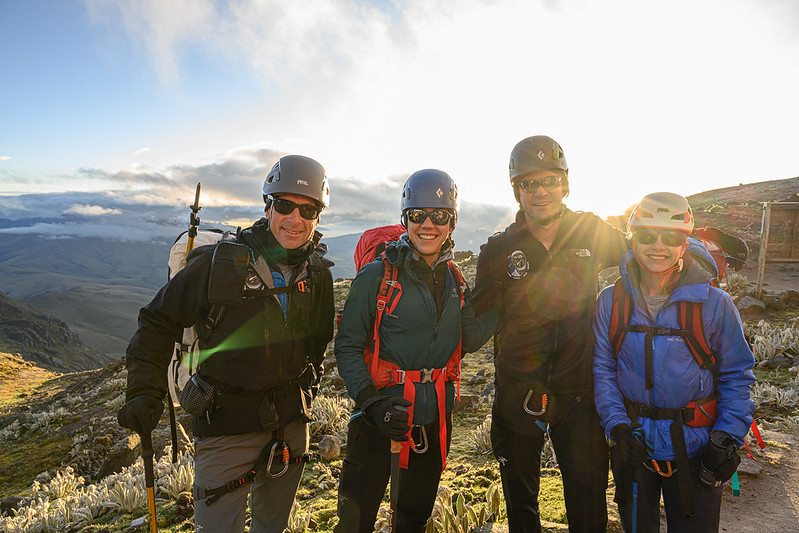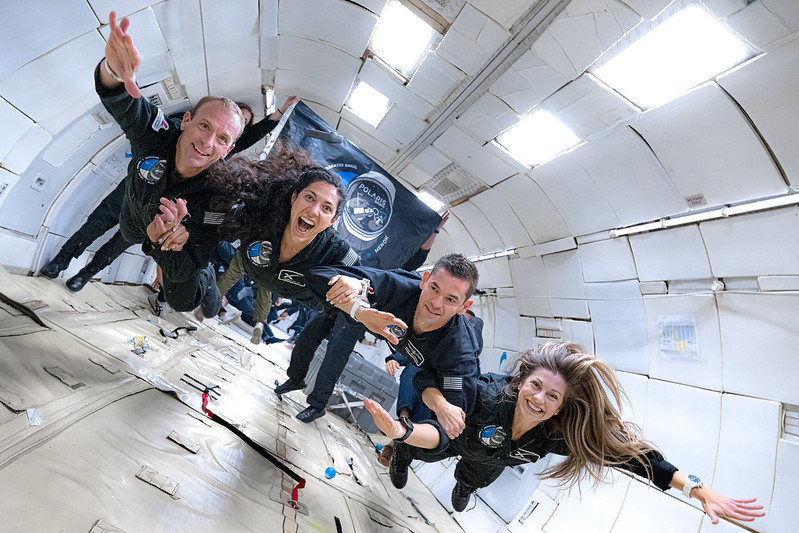
Even before joining the Polaris Dawn crew, Sarah Gillis was literally an expert in astronaut training. As part of her work at SpaceX, Gillis helps train all the astronauts who will go to Space in the Dragon spacecraft, so she knows a ton about how to operate and live in the spacecraft safely. However, Gillis’ new role as a Polaris Dawn crew member means she will be heading into space herself. Along with this new job comes quite a bit of new training—and astonishing adventures!

High altitude mountain Climbing in Ecuador (Cotopaxi)
Crew is training for…
Working as a team when you are not physically at your best, Changes in air pressure, Collaboration in challenging and risky environments

Earning Jump Wings for Parachuting
Crew is training for…

Scuba diving
Crew is training for…
Microgravity analog environment, Equipment maintenance and care, Communicating nonverbally (like during a space walk)

Living in a Pressurized Chamber
Crew is training for…
Understanding physical responses to changes in air pressure and oxygen concentration required for performing an EVA, Monitoring and reporting their medical conditions while in space

Taking a Parabolic Flight
Crew is training for…
Physical adjustments to microgravity, Carrying out research procedures in microgravity

Fighter Jet Training
Crew is training for…
Experiencing high acceleration forces (high Gs), Following complex procedures and checklists, Collaboration in high stakes environments
Some parts of crew training involve skill-building and acquiring new knowledge, like studying essential medical care, or learning how to capture data and use equipment for the dozens of in-space experiments the crew will carry into orbit. Other parts of training focus on the intense physical challenges that come along with space travel. The crew will experience tremendous forces of acceleration, significant changes in air pressure, and of course a completely different relationship with gravity. In orbit, the crew will live in a microgravity environment where objects (including themselves) float through the air as if they were weightless!
Watch below to learn how these team building adventures prepare the Polaris Dawn crew for new experiences in space, as well as hear Jared Isaacman and Joe Tanner help Sarah imagine what it will actually feel like to experience space’s microgravity.
Developing Teamwork

Jared Isaacman talking about space

For the Polaris Dawn crew, preparing to live and work in microgravity involves a combination of on-earth preparation and experimentation. Here on earth, you too can experiment as if you’re preparing for a microgravity adventure of your own. While gravity affects nearly all day-to-day activities –eating, writing, even sleeping– this challenge is going to focus on gravity and making music. So, grab an instrument and tackle your own microgravity mini-training session using the physical and mental experiments below. Try them out and see if you can answer this Zone’s Challenge Question:
Start by standing or sitting in a comfortable space — no musical instruments needed yet! Try each of the thought experiments below to first bring your focus to your body’s interactions with gravity.
- Find a comfortable sitting or standing position.
- Notice where your body is making contact with a surface, like your feet on the ground or your seat on a chair.
- Imagine relaxing the weight of your body and sinking down into those surfaces.
- Take 3-5 slow breaths. Feel heavy. Feel Grounded.
Gravity Awareness Experiment #2
- From a comfortable sitting or standing position, notice again where your body is making contact with a surface.
- This time, imagine the ground and the surfaces you are touching are giving you support by pushing you up.
- Picture that your body is lightly balanced, with energy pressing up through you from the ground all the way to the top of your head.
- Take 3-5 more slow breaths. Feel your spine expanding upwards.
Now that you’ve turned up your awareness of gravity here on earth, grab your musical instrument. Start playing and bring your focus to your connection with gravity as you move.
- What are some ways you already think about gravity as you play?
- Are there parts of playing that need to feel heavy, or parts that need to feel support from below?
- How does gravity help you? What’s more challenging because of gravity’s pull or push?
Next, disrupt your normal playing position and explore new interactions with gravity by lying down on your back. (If lying down flat isn’t possible, experiment with lying on your side or leaning dramatically at an angle.) Try playing your instrument from this new position.
- Where do you feel heaviness now? Where do you feel support?
- How have your movements changed? What’s easier–and what’s harder, or maybe even impossible?
Finally, return to a comfortable position for your last experiment (and this one will just be a “thought experiment”—something you do with your mind.) Try to imagine playing in microgravity without those familiar feelings of weight and support you experience on earth.
- Where might you notice these changes the most as you play?
- How might you have to adjust in order to create sound or use your instrument comfortably?
Want to share what it was like to experiment with gravity while playing? Tell us or share photos by posting on social media using the hashtag #space4music. We will be sharing selected submissions in this Zone’s Challenge Accepted! space. A few messages may even make it to space with Sarah Gillis!
Gravity is an invisible “pulling” force between the mass of two objects. The force of gravity changes depending on how far apart or how large the interacting objects are.
On earth, the pull of gravity between our body mass and earth’s mass keeps us from floating away from the planet’s surface. When a spacecraft enters orbit it is moving so fast around the earth that it actually falls around the planet, rather than falling to the ground. Because the people and objects inside the spacecraft are falling at the same rate they experience weightlessness, or floating in space. This is called a microgravity environment.

- Find more answers to questions about microgravity here:
- See how laws of motion work in microgravity by watching demonstrations by NASA astronauts on the International Space Station:
- Read a digital storybook for more microgravity fundamentals, perfect for early readers: The Astro-Not-Yets Explore Microgravity
One way to experience being in microgravity without leaving earth’s atmosphere is during a parabolic flight. In a parabolic flight, pilots make a special maneuver to create a microgravity environment within an airplane for short spurts of time.

Astronauts like Sarah Gillis often have their first experiences with microgravity during a parabolic flight. Scientists also use parabolic flights to test equipment and procedures that eventually may end up being used in space’s microgravity.

Flute
Each time astronaut Ellen L. Ochoa blew into her flute, the force of her breath was enough to move her backwards through space. Strapping her feet down helped keep her place.

Saxophone

Guitar


